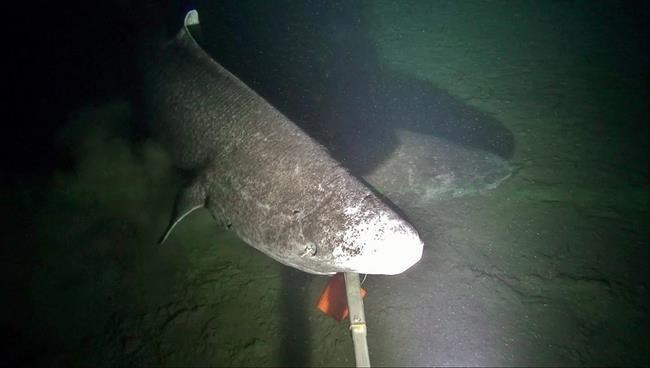
An image of a Greenland shark is shown in this handout photo provided by researchers from Marine Institute Scientists from Newfoundland have captured video of one of the marine world's largest and most elusive shark species. THE CANADIAN PRESS/HO-Marine Institute of Memorial University *MANDATORY CREDIT*
Republished March 02, 2018 - 9:36 AM
Original Publication Date March 02, 2018 - 3:41 AM
ST. JOHN'S, N.L. - Researchers probing the frigid depths of the Canadian Arctic got a rare glimpse of one of the oldest and most elusive creatures on Earth, providing valuable insight into just how many of the massive creatures are left.
A small team of scientists from the Marine Institute in Newfoundland said they counted 142 individual Greenland sharks in five different areas off Nunavut, where they deployed a baited remote underwater camera.
The data — including 258 hours of video footage of the slow-moving sharks — provides some of the first local abundance estimates of one of the largest and longest-lived marine species.
"We had no baseline for how many sharks should be there, it's all new information," lead author Brynn Devine said from St. John's.
"They're really fun to watch and maybe not quite as exciting as a great white shark that would be really vicious and attacking the camera, but it was really cool to see."
Greenland sharks can reach seven metres in length and are a top predator feeding primarily on bottom fish and seals. They can live up to at least 270 years and possibly up to 400 years.
Devine says researchers have made a rough population estimate of between one to five sharks per square kilometre in most of the sampling regions, which were surveyed from July to September in 2015 and again in 2016. But, she cautions that the figures are from a limited number of camera deployments and more work is needed to come up with more accurate numbers.
In Admiralty Inlet, the camera captured 18 individual sharks. The study says that the highest number of sharks seen per hour were in Arctic Bay and were lowest in Resolute. The other areas sampled included central Lancaster Sound, Southeast McDougall Sound and Scott Inlet.
The peer-reviewed study on the Greenland shark was recently published in the journal Scientific Reports. Devine and her team travelled to the Arctic region on board a fishing vessel and deployed the camera in waters as deep as 800 metres.
The soundless footage shows dappled grey sharks swimming slowly past the camera, along a dark, muddy bottom. One of the sharks — identified by distinct scars and markings — tries to take a bite out of the camera stake and stares directly into the camera before venturing away.
Devine said the majority of the sharks they saw had not yet reached maturity as they appeared to be smaller than adults.
But, she said so little is known about the species that the findings could be an important first step in getting a handle on the population size and range. What little is known about their numbers is taken from fisheries catches, when the sharks are caught as bycatch, and historical commercial exploitation.
"There's no information out there," she said. "The species is just so poorly understood."
The International Union for the Conservation of Nature has listed Greenland sharks as near threatened, with the caveat that nothing is known about their density.
The species used to be fished for liver oil until 1960, with "annual catch estimates in the early 20th century ranging from 32,000 to 150,000 sharks in Greenland and Norway," according to the study. The sharks are still caught for human and sled-dog consumption.
- By Alison Auld in Halifax
News from © The Canadian Press, 2018